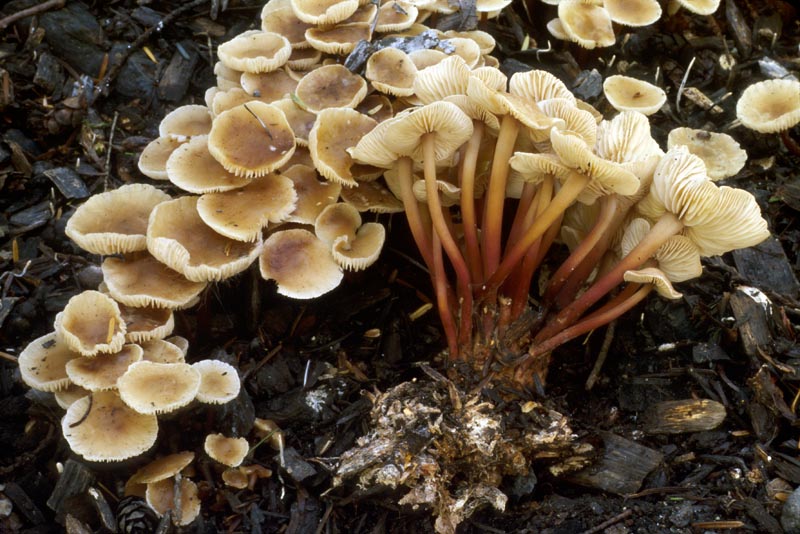Distribution: Northern hemisphere
Habitat: Forested areas
Conservation Status: Not of concern
Edibility: Gymnopus erythropus is a small to medium-sized mushroom usually found in tight clusters. The caps are rounded, brown to reddish brown and striate when fresh, then become flattened and fade to lighter brown, brownish orange, or buff. The gills are attached, sometimes forked, rather broad, close, and whitish. The stipes are fibrous and somewhat elastic, hollow, equal, pallid to pale orangeish above and dark reddish to orange-brown or brown below, and usually with reddish to orange-brown hairs at the base. The mushrooms are long-lived and the caps fade to whitish with age but the red color of the stipes persists. G. erythropus is often abundant in gardens and landscaped areas on soil, wood chips, or woody litter. Whether it has become naturalized in our forests is unclear, but we have collected it in one of Seattle’s forested parks. It has been reported from both eastern and western North America and is known from Europe and other parts of the world, sometimes under the name Collybia marasmioides (Britzelmayr) Bresinsky & Stangl. G. erythropus was not included in Joanne Williams-Lennox’s 1975 PhD dissertation on collybioid fungi which could indicate it has been introduced here since then. It could be confused with Gymnopus acervatus, but the latter is found in forested areas, its caps and stipes both are purplish when young, the caps are much narrower in relation to the stipe length, and it occurs in larger, tighter clusters.
Gymnopus erythropus is a small to medium-sized mushroom usually found in tight clusters. The caps are rounded, brown to reddish brown and striate when fresh, then become flattened and fade to lighter brown, brownish orange, or buff. The gills are attached, sometimes forked, rather broad, close, and whitish. The stipes are fibrous and somewhat elastic, hollow, equal, pallid to pale orangeish above and dark reddish to orange-brown or brown below, and usually with reddish to orange-brown hairs at the base. The mushrooms are long-lived and the caps fade to whitish with age but the red color of the stipes persists. G. erythropus is often abundant in gardens and landscaped areas on soil, wood chips, or woody litter. Whether it has become naturalized in our forests is unclear, but we have collected it in one of Seattle’s forested parks. It has been reported from both eastern and western North America and is known from Europe and other parts of the world, sometimes under the name Collybia marasmioides (Britzelmayr) Bresinsky & Stangl. G. erythropus was not included in Joanne Williams-Lennox’s 1975 PhD dissertation on collybioid fungi which could indicate it has been introduced here since then. It could be confused with Gymnopus acervatus, but the latter is found in forested areas, its caps and stipes both are purplish when young, the caps are much narrower in relation to the stipe length, and it occurs in larger, tighter clusters.
PNW Herbaria: Specimen records of Gymnopus erythropus in the Consortium of Pacific Northwest Herbaria database
CalPhotos: Gymnopus erythropus photos



